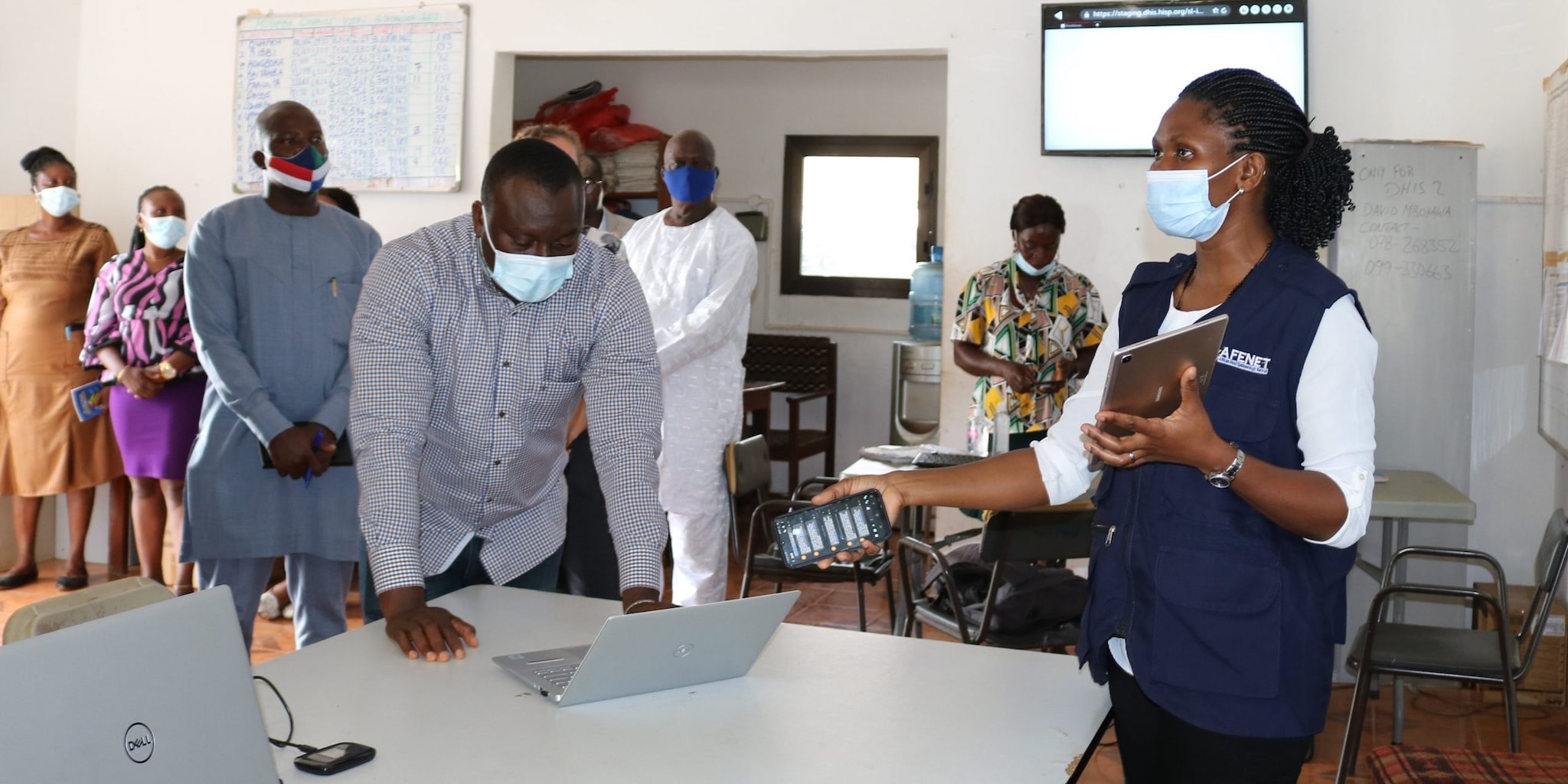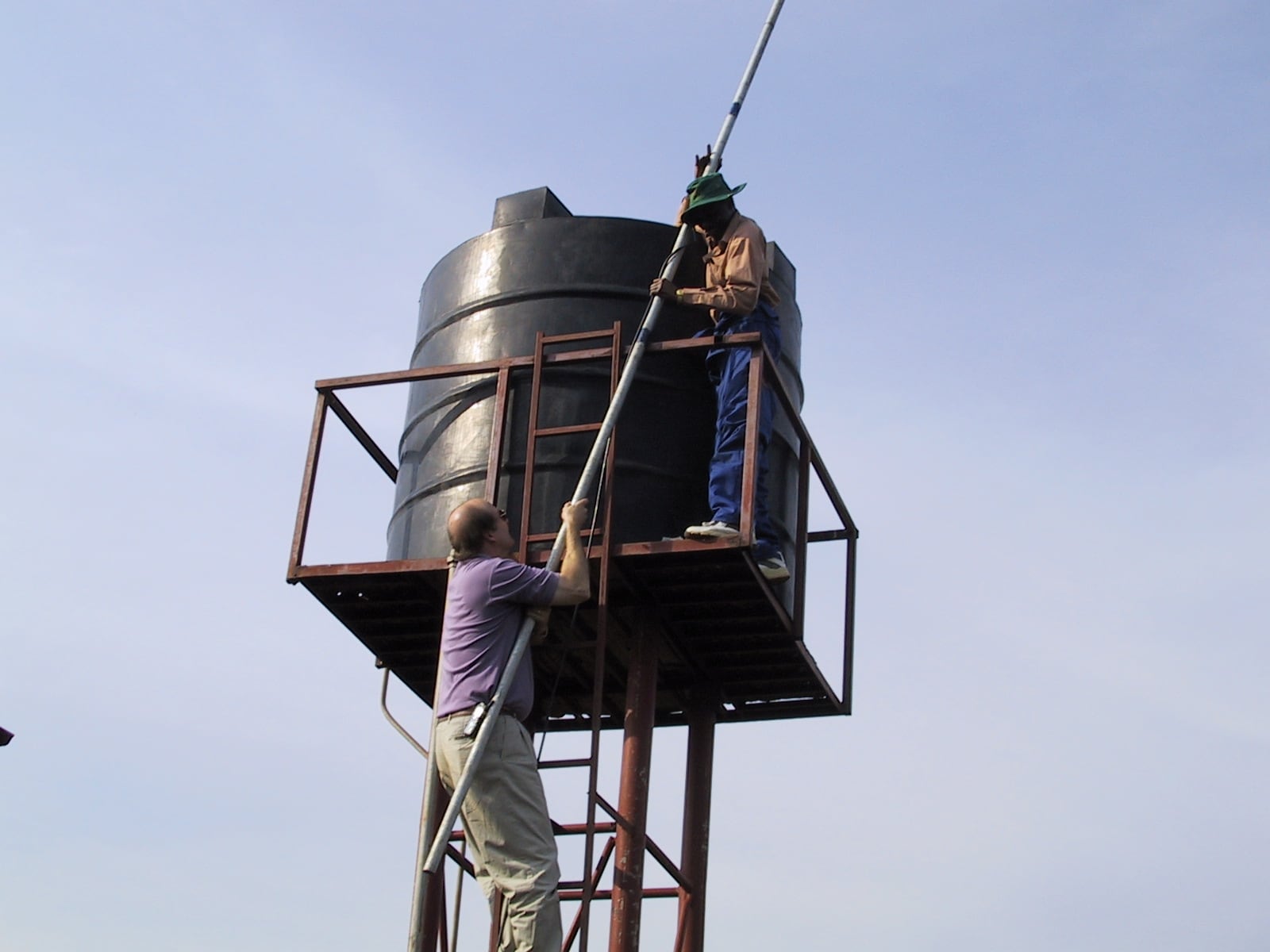Collaborating to Strengthen Surveillance Systems Worldwide
February 28, 2023

Bridget Magoba, African Field Epidemiology Network (AFENET) demonstrates using the electronic case-based disease surveillance system (eCBDS) with a tablet. Photo: Philip S. Turay/U.S. Embassy, Sierra Leone
Surveillance systems are an essential component of every country’s core emergency response capability. CDC collaborates with more than 45 countries and regions to develop and support quicker and stronger surveillance systems that generate the data needed for rapid response during public health emergencies and improve global health security. Through training, technological innovations, and partnerships, CDC has prepared countries to monitor, find, and track outbreaks, as well as generate data that informs emergency response. These surveillance data are essential to guide and plan interventions, as well as to pinpoint where to look for new and unknown pathogens (bacteria, viruses, fungi, or other organisms that cause illness), allowing countries to effectively prevent, detect, and respond to disease threats.
With CDC support, Sierra Leone’s pilot program for an electronic case-based disease surveillance system (eCBDS) was completed, allowing country leaders to make strategic decisions in reducing the threat of COVID-19. As COVID-19 spread, Sierra Leone quickly implemented its newly developed eCBDS, which is built upon the District Health Information Software (DHIS2). The DHIS2 software supports data collection, analysis, and visualization. Through DHIS2, data on individual cases of COVID-19 are captured using a mobile application. This allows national health officials to receive SMS (text) messages and emails when COVID-19 is detected. Additionally, CDC provided Sierra Leone Ministry of Health with technical assistance in March 2021 to customize the DHIS2 vaccine toolkit to manage COVID-19 vaccination data through the African Field Epidemiology Network and Health Information Systems Program-South Africa. Sierra Leone has integrated this vaccine tracking system into eCBDS, used throughout the country’s 16 districts. With this system, health officials can track doses administered, and providers can easily schedule appointments, send appointment reminders via SMS, report adverse side effects, and track missed appointments.
CDC’s technical collaboration on Sierra Leone’s surveillance strategy enables consistent collection and communication of COVID-19 data from all testing sites. Sierra Leone’s investment in the eCBDS is providing a successful health data system to support the country’s COVID-19 response, while preparing for future threats through a more sustainable surveillance system.
SIVIGILA, Colombia’s public health surveillance system, was developed 15 years ago. The program has since been a key component of the continuing collaboration with CDC and Colombia’s National Public Health Institute, Instituto Nacional de Salud (INS), a partnership that started in 1992 with the Field Epidemiology Training Program (FETP). Ongoing commitment to the development of SIVIGILA highlights the importance of building public health surveillance capacity in Colombia and its network of over 14,000 local health service providers.
During the COVID-19 pandemic, INS used SIVIGILA to identify trends and share information for decision-making. SIVIGILA expanded the reporting network to include municipal, departmental, and district level units and scaled-up the number of records captured from an estimated 1.5 million records collected in 2019 to an estimated 36 million in 2021. Epidemiologists and public health professionals—including FETP residents and graduates—used the system to identify and monitor COVID-19 hotspots and inform investigations. The country also expanded the integrated Laboratory Information System (SIVILAB) with new modules that increased available health data and enabled rapid genomic surveillance. The data were used for complex analyses and provided comprehensive information to the health system and external partners using interactive dashboards and real-time geographic visualizations.
With CDC’s continued support, INS promotes work that improves and streamlines public health data sharing. SIVIGILA is supporting One Health by bringing together animal health data from veterinary and agricultural monitoring into the system, ensuring the compatibility of databases with SIVILAB, and expanding electronic medical record keeping. These efforts and the ongoing collaborations between CDC and INS continue to improve the capacity of Colombia and the region to prevent, detect, and respond to public health threats.

With 235 million people in 36 countries requiring humanitarian assistance in 2021, CDC and its partner organizations must have a structure in place for deployment to coordinate resources for organized and rapid emergency response. For over 20 years, CDC and the Global Outbreak Alert and Response Network (GOARN) have collaborated to deliver and strengthen public health systems.

CDC’s Ray Arthur (top) helps install a radio antenna to transmit Ebola messages and songs at an Internally Displaced Person (IPD) camp in 2000 for those escaping Joseph Kony’s Lord’s Resistance Army in northern Uganda. Photo: WHO
In 2000, CDC was one of the 60 founding institutions of GOARN and continues to be an important partner and leader in the network. CDC provides personnel and coordinates response activities with GOARN through the Global Disease Detection and Operations Center (GDDOC) team, helping deploy, train, and develop trainings for rapid response teams. One of the important roles CDC plays with GOARN is conducting event-based surveillance (EBS), which identifies and tracks infectious diseases and other public health events.
Recently, CDC has deployed subject matter experts to the 2022 Ukraine response as well as the 2022 Uganda Ebola outbreak, which is the largest since the 2000 outbreak in Gulu, Uganda. In October 2022, CDC employees were deployed to support GOARN partners in the implementation of the Go.Data project, a data collection and analysis tool for outbreaks.
Since June 2021, CDC has also been a member of the Integrated Outbreak Analytics (IOA) Global Network, a new partnership under GOARN. IOA utilizes a multidisciplinary approach to understanding outbreak dynamics and informing outbreak response. It aims to drive comprehensive, accountable, and effective public health and clinical strategies by allowing communities and national and subnational health authorities to use data for operational decision-making.
CDC continues to work alongside GOARN to improve response capacity for future public health emergencies with a stronger country-level focus, as well as enhanced regional development and network operations.
CDC is collaborating with countries and partners to utilize disease surveillance innovations to save lives. Disease detection, testing, and monitoring can save lives if work efforts are quickly shifted to meet current needs and surveillance is strengthened to be timely, complete, and representative. Continued investment in surveillance, diagnostics, and safety also allows countries to respond to future public health emergencies more effectively.